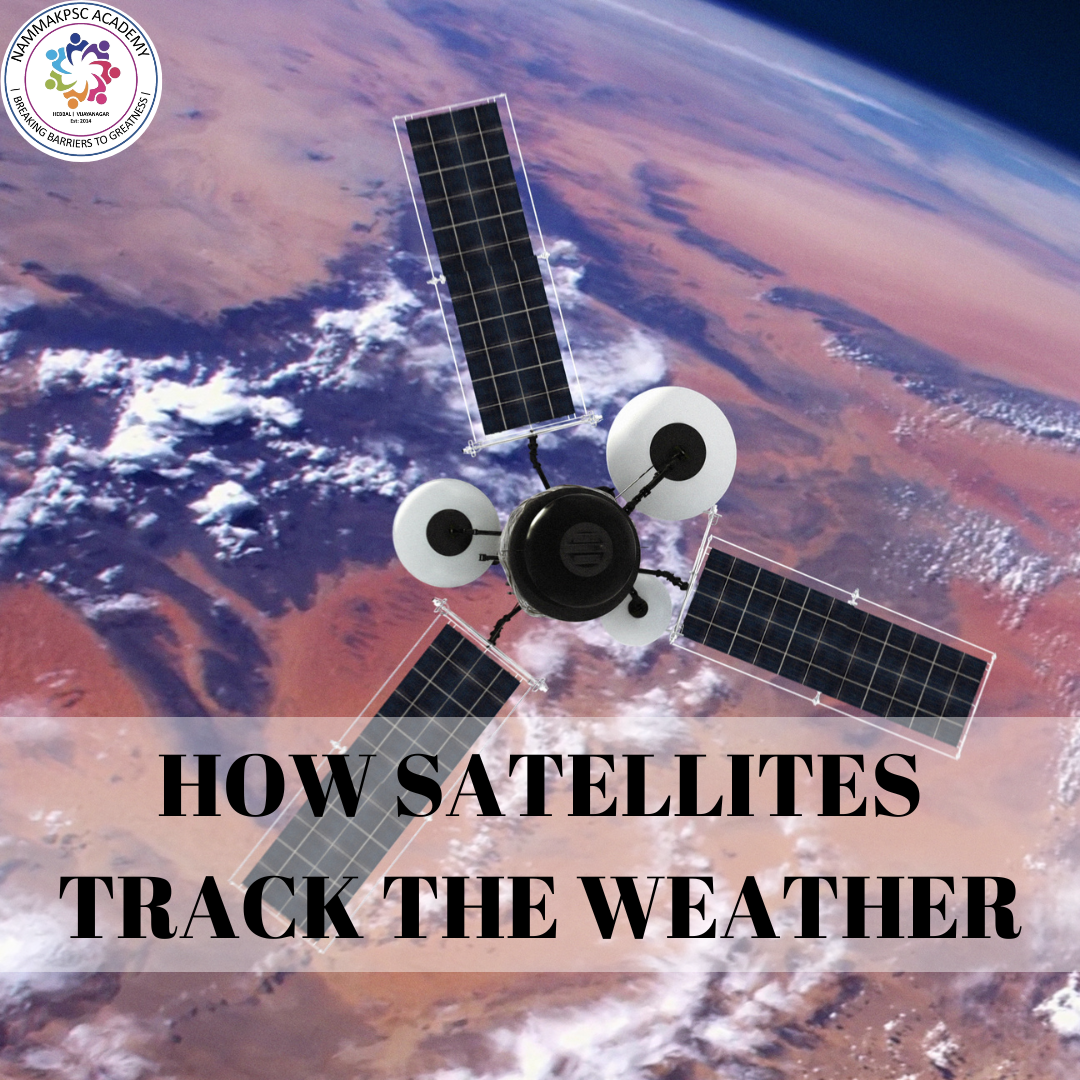Published on: January 19, 2024

HOW SATELLITES TRACK THE WEATHER
HOW SATELLITES TRACK THE WEATHER

How does one read the maps? What do the colours represent?
- At the bottom right of a map from 2021 (map 1) is a clue — ‘Night Microphysics’. According to a paper published by IMD scientists in February 2019, the INSAT 3D satellite has a red-green-blue, or RGB, imager whose images’ colours are determined by two factors: solar reflectance and brightness temperature.
- Solar reflectance is a ratio of the amount of solar energy reflected by a surface and the amount of solar energy incident on it. Brightness temperature has to do with the relationship between the temperature of an object and the corresponding brightness of its surface. It is different from temperature as we usually understand it — like the temperature we ‘feel’ when we touch a glass of hot tea — because brightness temperature also has to do with how the tea glass emits the thermal radiation, which is at different frequencies in different directions.
- The INSAT 3D’s ‘day microphysics’ data component studies solar reflectance at three wavelengths: 0.5 micrometres (visible radiation), 1.6 micrometres (shortwave infrared radiation) and 10.8 micrometres (thermal infrared radiation). That is, detectors onboard the satellite track radiation coming from over India in these wavelengths
- The strength of the 0.5 micrometre visible signal determines the amount of green colour; the strength of the 1.6 micrometre shortwave infrared signal, the amount of red colour; and the strength of the 10.8 micrometre thermal infrared signal, the amount of blue colour. This way, the INSAT 3D computer determines the colour on each point of the image.
How does the satellite track snow?
- Major applications of this colour scheme are an analysis of different cloud types, initial stages of convection, maturing stages of a thunderstorm, identification of snow area, and the detection of fires
- While the solar reflectance of snow and that of clouds is similar in the visible part of the spectrum, snow strongly absorbs radiation of wavelength 1.6 micrometre, that is the shortwave infrared
- As a result, when the satellite tracks snow, the red component of the colour scheme becomes very weak
How are the colours determined?
- The satellite’s ‘night microphysics’ component is a little more involved. Here, two colours are determined not by a single signal but by the strength of the difference between two signals
- The computer determines the amount of red colour according to the difference between two thermal infrared signals — 12 micrometre and 10 micrometre
- The amount of green colour varies according to the difference between a thermal infrared and a middle infrared signal — 10.8 micrometre and 3.9 micrometre.
- The amount of blue colour is not a difference but is determined by the strength of a thermal infrared signal of wavelength 10.8 micrometre.
- By combining day and night microphysics data, atmospheric scientists can elucidate the presence of moisture droplets of different shapes and temperature differences over time, and in turn track the formation, evolution and depletion of cyclones and other weather events.
- For example, taking advantage of the fact that INSAT 3D can produce images based on signals of multiple wavelengths, the authors of the 2019 paper have proposed day and night microphysics data that they say would indicate a thunderstorm impending in one to three hours.
How do the satellites collect weather data?
- Both INSAT 3D and INSAT 3DR use radiometres to make their spectral measurements. A radiometre is a device that measures various useful properties of radiation, typically by taking advantage of radiation’s interaction with matter, for example in the form of temperature or electrical activity.
- Both satellites also carry atmospheric sounders. These are devices that measure temperature and humidity, and study water vapour as a function of their heights from the ground.
- Scientists combine the radiometre and sounder measurements to understand various atmospheric characteristics.
What weather satellites does India have?
- According to the INSAT 3DR brochure, its radiometer is an upgraded version of the very-high-resolution radiometer (VHRR) that the Kalpana 1 and INSAT 3A satellites used (launched in 2002 and 2003, respectively).
- The Space Application Centre’s brief for INSAT 3A states: “For meteorological observation, INSAT-3A carries a three channel Very High Resolution Radiometer (VHRR) with 2 km resolution in the visible band and 8 km resolution in thermal infrared and water vapour bands.” The radiometers onboard 3D and 3DR have “significant improvements in spatial resolution, number of spectral channels and functionality”.
- The Kalpana 1 and INSATs 3A, 3D, and 3DR satellites aided India’s weather monitoring and warning services with the best technology available in the country at the time, and with each new satellite being a better-equipped version of the previous one. So while Kalpana 1 had a launch mass of 1,060 kg and carried a early VHRR and a data-relay transponder, INSAT 3DR had a launch mass of 2,211 kg — in 2016 — and carried an upgraded VHRR, a sounder, a data-relay transponder and a search-and-rescue transponder. India deactivated Kalpana 1 in September 2017, after 15 years in orbit.
- The INSAT 3D and 3DR satellites are currently active in geostationary orbits around the earth, at inclinations of 82 degrees and 74 degrees east longitudes respectively.
- In February 2024, the Indian Space Research Organisation is expected to launch the INSAT 3DS meteorological satellite onboard its GSLV Mk II launch vehicle, with a launch mass of two tonnes. While “3DR” stood for “3D repeat”, “3DS” stands for “3D second repeat”.

